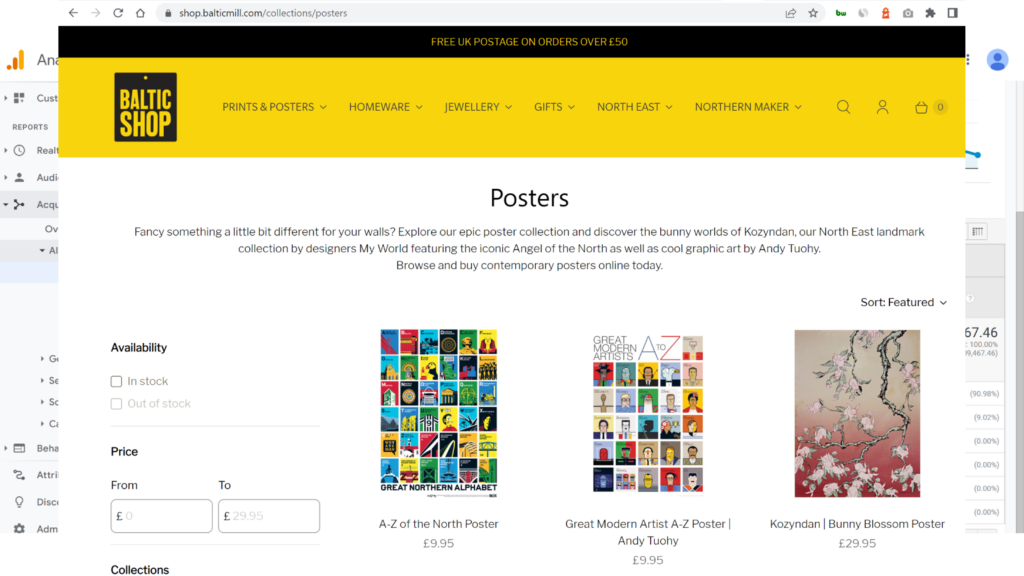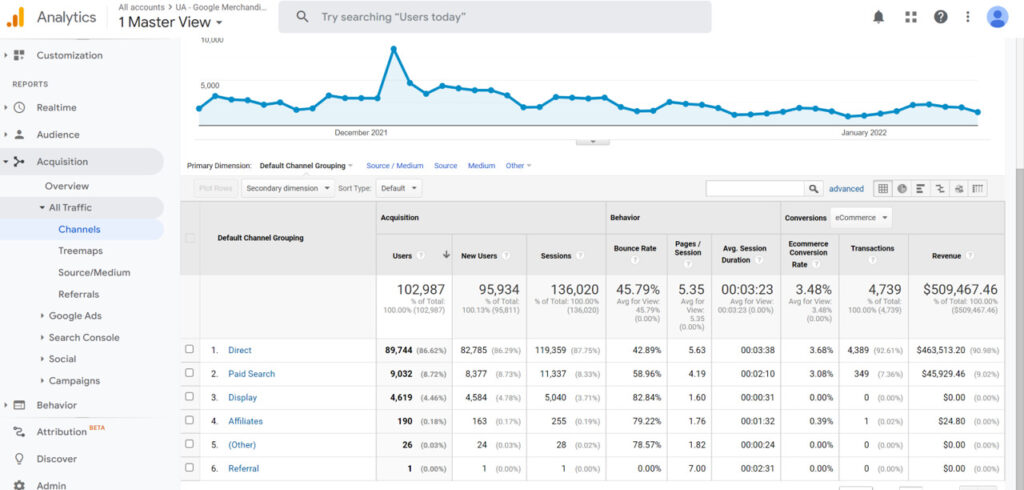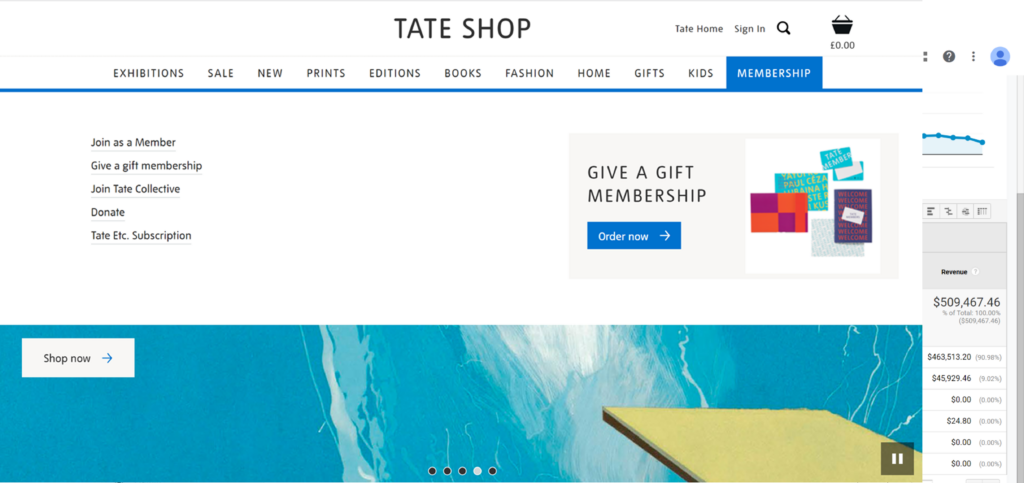How to set a winning festive eCommerce strategy
As we covered in the first part of our festive eCommerce series, the festive period is a great time to drive online sales. In this article we’ll explore how creative and cultural individuals and organisations can develop a winning eCommerce strategy for this period.
Think like a retailer
Christmas is the most important time of the year for most retailers and as a result they do a lot of planning and analysis to ensure they maximise their sales in this period. The first step is to start planning early – it’s not unusual for retailers to be finalising their Christmas plans in the summer! So if you haven’t already started, it’s a good idea to get going with your plans in the autumn.
The next step is to use your data. Retailers use their experience of how they traded over the previous festive period to inform their strategy for the coming period. The idea is to have a really strong understanding of what the drivers of success were last year and where opportunities lie to make improvements this year.
Read on and we’ll guide you through some simple checks and investigations that your organisation can carry out.
Get your dates straight
The peak festive trading period starts in mid-November and runs through to early January. Each year key dates can fall on different days of the week and this can have a big impact on how the trading period plays out. Here are the key dates you need to be aware of through the festive period:
- Thanksgiving – this US holiday falls on the 4th Thursday of November and has become important to organisations worldwide, as it has given rise to the phenomenon that is Black Friday …
- Black Friday – falls on the Friday after Thanksgiving when US retailers offer customers big discounts and promotions. Over recent years, ‘Black Friday’ promotions have spread to the UK and other countries. Though these promotions may appear to be a cultural import from the US, the last weekend in November has always been a key date in UK retailers’ trading calendars as this is when people tend to receive their last monthly pay before Christmas.
In 2022 Black Friday falls on Friday 25th November
- Cyber Monday – falls three days after Black Friday. Monday evenings tend to be a peak time for online shopping – equivalent to visiting a busy shopping centre on a Saturday afternoon! Cyber Monday is the busiest online Monday of the year and as a result many retailers continue to offer big promotions to drive online sales in the run-up to Christmas.
In 2022 Cyber Monday falls on Monday 28th November
- Your last order dates – it’s important to calculate what dates you should advertise as your last dates for ordering with guaranteed delivery before Christmas. These dates will vary for different delivery services – international customers, UK customers and UK customers who choose next day delivery services.
In order to calculate your last order date you need to confirm with your courier their last collection date from you for guaranteed Christmas delivery, then you need to take into account how much time your fulfilment team needs to process and pack orders, bearing in mind that order volumes can really leap in the last few days, as people shop for last-minute gifts. Using this information and building in a little buffer time, you and your team can agree on ‘last order dates’ that you’re comfortable advertising to your customers for delivery before Christmas.
- Christmas Eve – this falls on the 24th of December and is usually the last working day before Christmas itself, unless Christmas Day falls on a Monday, in which case the 23rd of December will be your last delivery day.
- Christmas Day – this falls on the 25th of December and is a public holiday in the UK. Many people tend to be at home with friends and family, but surprisingly this can turn out to be a big day for shopping online. From mid-afternoon onwards, online traffic tends to pick up as people slump in front of festive TV, try out new devices they may have received for Christmas, or seek out gifts they didn’t receive for Christmas. Whatever the reason, many retailers choose this moment to launch Boxing Day / January sales.
Look at what happened last year
To review how things went last year, you can use the reporting functionality of your online shop platform – for example the dashboard in Shopify or WooCommerce. Or your website analytics – for example Google Analytics.
There are three areas of investigation that are important to interrogate and understand:
- Bestselling products
- Most important pages
- Most important marketing channels
For each of these areas, you should focus on last year’s festive period – we would suggest a sensible date range to consider would be Monday 22nd November 2021 through to Sunday 9th January 2022 – and put on your detective hat!
If you need help navigating the reporting functionality of your eCommerce or analytics platform, do reach out to the Digital Culture Network and we can provide you with 1-to-1 support in this area.
Bestselling products
Understanding which products are most popular in the festive period is important. You’ll want to look at:
- which products sold most in terms of value – i.e. £s of revenue
- which products sold most in terms of volume – i.e. quantity sold
Once you’ve identified your 5 to 10 bestselling products, you’ll want to zoom in on each of these and look at how they performed during the festive period. Was there a spike in sales on any particular days? If so, can you check your records and see if there was any particular marketing activity which might have boosted these sales – a newsletter or social media post for example?
In Google Analytics, the navigation path in the left hand menu to reach this reporting is: Conversions > Ecommerce > Product Performance.
Most important pages
It’s likely your homepage received the most traffic but have a look at which are the next most popular pages. In particular look for what we think of as ‘category pages’ in eCommerce. These are pages which list multiple products in a category, for example: YourWebsite.org/shop/books/gifts.
Below you can see an example of a category page for ‘Posters’.

Once you’ve identified your 5 to 10 most important category pages, you should look at how they performed by day. Was there a spike in traffic on any particular days? If so, again can you recall any particular marketing activity which might have boosted traffic to this page?
You can also do a reverse check, look at daily traffic through the period and see if there are any days which have particularly high traffic. For these high traffic days, zoom in on them and examine which were the most important pages on these days. If you’re using Google Analytics to look at this information you’ll also be able to look at which marketing channels were driving traffic to that page.
In Google Analytics, the navigation path in the left hand menu to reach this reporting is: Behaviour > Site Content > All Pages
Most important marketing channels
The last big area to check is which marketing channels were most important in driving your online traffic and sales last year.
The best place to access this information is in your analytics platform, such as Google Analytics. It’s also accessible in some eCommerce platforms, but often depends on what level of reporting you or your organisation pay for.
In Google Universal Analytics, you can navigate to these reports using the following navigation path: Acquisition > All Traffic > Channels.

Look at which marketing channels are driving the most traffic, revenue and transactions.
If you zoom into a particular channel, you’ll be able to see more detail about what sources are contributing to this marketing channel – for example within ‘Social Media’ you can see which networks are the source of your traffic e.g. Facebook, Twitter, Instagram etc.
As you’re examining your data from different angles, keep an eye out for days when traffic peaks for any particular channel. By now you should know the drill, and be hunting down the cause of that particular spike. For example, if you see that on the 12th December you had high levels of traffic coming from email – you should check back and see what email communications were sent out that day.
Get inside your customer’s head
Look at your product range for this Christmas and think about the key products to highlight to your customers:
- What products are new and appealing? If your organisation has a buying team – are there any new items they’re bringing in for this festive season?
- What products would make great gifts? Who would these gifts suit – Bookworms? Foodies? Children? Who else could they appeal too?
- Are there other products that your organisation offers that could be suitable for gifting? For example membership packages or gift vouchers?

Bringing it all together
You should now be armed with a good understanding of which:
- products
- marketing channels
- and days
were most important for driving your sales during the Christmas period last year.
You should also have identified a range of products and categories from this year’s range which would be good to highlight for Christmas gifting and promotions.
Using this information you can now put together a strategy for promoting your Christmas range.
1. Build gifting pages
Using your research, build category pages for key gifting ranges, for example:
- Gifts for book lovers
- Gifts for children
- Gifts under £10, £20 etc
Aim to have these pages live on your website by the 1st of November.
2. Merchandise existing category pages
Where products you’ve identified as important Christmas sellers feature in existing categories in your online shop, if you can, push these items to the top of the category page. Most eCommerce platforms will have a function that allows you to pin products to the top of a category page.
3. Promote gifting pages on your site
Make sure your new gifting pages are easy to find on your website.
- Use homepage banners to promote your gift pages
- Add your pages to your Shop Navigation
4. Promote gifting pages externally
Use your research into marketing channels to inform how you promote your gifting pages.
- Use email newsletters to inform your audience about your great Christmas gift ranges
- Use social media to introduce your audience to your star Christmas products and ranges
We hope you’re excited to put your festive eCommerce strategy into action. Read more about how you can drive your online sales with our articles about:
How to run successful festive promotions for your online shop
Your Christmas eCommerce conversion checklist
Where’s my order? 5 customer service quick wins for the festive period
What’s next?
The Digital Culture Network is here to support you and your organisation. Our Tech Champions can provide free 1-2-1 support to all arts and cultural organisations who are in receipt of, or eligible for, Arts Council England funding. If you need help or would like to chat with us about any of the advice we have covered above, please get in touch. Sign up to our newsletter below and follow us on Twitter @ace_dcn and LinkedIn for the latest updates.










